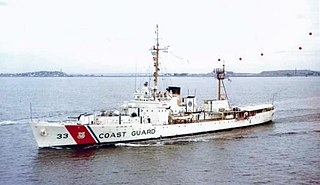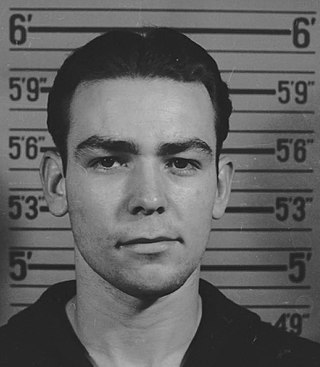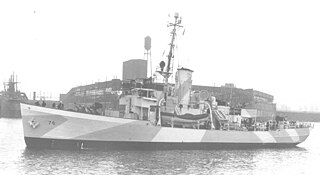
USCGC Storis (WAGL-38/WAG-38/WAGB-38/WMEC-38) was a light icebreaker and medium endurance cutter which served in the United States Coast Guard for 64 years and 5 months, making her the oldest vessel in commission with the Coast Guard fleet at the time of her decommissioning.
The Medium Endurance Cutter or WMEC is a type of United States Coast Guard Cutter mainly consisting of the 270-foot (82 m) Famous- and 210-foot (64 m) Reliance-class cutters. These larger cutters are under control of Area Commands. These cutters have adequate accommodations for crew to live on board and can do 6 to 8 week patrols.
USS Algonquin may refer to the following ships operated by the United States Navy:

The Treasury-class cutter was a group of seven high endurance cutters launched by the United States Coast Guard between 1936 and 1937. The class were called the "Treasury class" because they were each named for former Secretaries of the Treasury. These ships were also collectively known as the "327's" as they were all 327 feet (100 m) in length. The Treasury-class cutters proved versatile and long-lived warships. Most served the United States for over 40 years, including with distinction through World War II, Korea, and Vietnam.

The USCGC Escanaba (WPG-77) was a 165 ft (50 m) "A" type United States Coast Guard cutter stationed on the Great Lakes from her commissioning in 1932 until the start of U.S. military involvement in World War II in 1941. With the outbreak of war, Escanaba redeployed to participate in the Battle of the Atlantic, during the course of which she was ultimately lost with nearly all hands. Struck by either a torpedo or mine in the early morning of 13 June 1943, while serving as a convoy escort, Escanaba suffered a fiery explosion and sank within minutes, leaving only two survivors and one body out of her 105-man crew to be found on the surface by rescuers.

USCGC Duane (WPG-33/WAGC-6/WHEC-33) was a cutter in the United States Coast Guard. Her keel was laid on May 1, 1935 at the Philadelphia Navy Yard, Philadelphia, Pennsylvania. She was launched on June 3, 1936 as a search and rescue and law enforcement vessel.

United States Coast Guard Cutter is the term used by the U.S. Coast Guard for its commissioned vessels. They are 65 feet (19.8 m) or greater in length and have a permanently assigned crew with accommodations aboard. They carry the ship prefix USCGC.

USCGC Escanaba (WMEC-907) is a United States Coast Guard medium endurance cutter based in Portsmouth, Virginia. Her keel was laid on April 1, 1983, at Robert Derecktor Shipyard Incorporated, Middletown, Rhode Island. She was launched February 6, 1985 and is named for her predecessor, USCGC Escanaba (WPG-77) which sank during World War Two, and was named for the Escanaba River and Escanaba, Michigan. Escanaba (WMEC-907) was formally commissioned August 29, 1987 in Grand Haven, Michigan, the home port of her predecessor.

USCGC Campbell (WMEC-909) is a United States Coast Guard medium endurance cutter based at Naval Station Newport in Newport, Rhode Island. Campbell is the sixth Coast Guard Cutter to bear the name and is assigned to the Atlantic. The ship bears the distinction of having made some of the largest narcotics seizures in Coast Guard history as well as being the command ship for the TWA 800 recovery effort.

USCGC Tahoma (WPG-80) was a United States Coast Guard Cutter built by the Defoe Shipbuilding Company in Bay City, Michigan. Completed in 1934, the steel-hulled cutter operated on the Great Lakes between 1934 and 1941, attached to the 9th Coast Guard District and homeported at Cleveland, Ohio. She was named after the Tahoma Glacier on the western slope of Mount Rainier in the state of Washington.

USCGC Iroquois (WHEC-43) was an Owasco-class high-endurance cutter built for World War II service with the United States Coast Guard. The war ended before the ship was completed and consequently she never saw wartime service.

USCGC Escanaba (WHEC-64) was an Owasco-class high endurance cutter built for World War II service with the United States Coast Guard. The war ended before the ship was completed and consequently she never saw wartime service.

USCGC Tampa was a United States Coast Guard Cutter that served in the United States Coast Guard from 1921 to 1941, and then in the United States Navy from 1941 to 1947.
Three United States Coast Guard Cutters have been named Escanaba:

Forrest O. Rednour (1923–1943) was a United States Coast Guardsman who received the Navy and Marine Corps Medal posthumously for his actions during World War II.

USCGC Comanche (WPG-76) was a United States Coast Guard cutter built by Pusey & Jones Corporation, Wilmington, Delaware, and launched 6 September 1934. She was commissioned on 1 December 1934. She was used extensively during World War II for convoy operations to Greenland and as a part of the Greenland Patrol.

USCGC Alexander Hamilton (WPG-34) was a Treasury-class cutter. She was named after Founding Father and the first U.S. Secretary of the Treasury, Alexander Hamilton. Sunk after an attack by a German U-boat in January 1942, the Hamilton was the U.S. Coast Guard's first loss of World War II.

The USCGC North Star was a United States Coast Guard Cutter during the Second World War. It was originally built for the U.S. Interior Department and served in the United States Coast Guard (USCG) before being acquired by the U.S. Navy.

The Greenland Patrol was a United States Coast Guard operation during World War II. The patrol was formed to support the U.S. Army building aerodrome facilities in Greenland for ferrying aircraft to the British Isles, and to defend Greenland with special attention to preventing German operations in the northeast. Coast Guard cutters were assisted by aircraft and dog sled teams patrolling the Greenland coast for Axis military activities. The patrol escorted Allied shipping to and from Greenland, built navigation and communication facilities, and provided rescue and weather ship services in the area from 1941 through 1945.
















